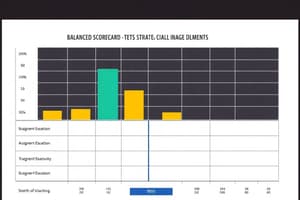Podcast
Questions and Answers
The Balanced Scorecard model was first introduced in 1989.
The Balanced Scorecard model was first introduced in 1989.
False (B)
The Balanced Scorecard is primarily used to manage financial performance in organizations.
The Balanced Scorecard is primarily used to manage financial performance in organizations.
False (B)
A Strategy Map in the Balanced Scorecard comprises four distinct perspectives of performance.
A Strategy Map in the Balanced Scorecard comprises four distinct perspectives of performance.
True (A)
The critical components of the Balanced Scorecard include measurements, targets, and projects only.
The critical components of the Balanced Scorecard include measurements, targets, and projects only.
Approximately 70% of the Fortune 1,000 companies employ the Balanced Scorecard to improve performance management.
Approximately 70% of the Fortune 1,000 companies employ the Balanced Scorecard to improve performance management.
The Balanced Scorecard is only utilized in the private sector and has no application in the public sector.
The Balanced Scorecard is only utilized in the private sector and has no application in the public sector.
Strategy can be visualized through four views of performance according to the Balanced Scorecard approach.
Strategy can be visualized through four views of performance according to the Balanced Scorecard approach.
The first significant focus of the Balanced Scorecard was on aligning financial measures with strategic goals.
The first significant focus of the Balanced Scorecard was on aligning financial measures with strategic goals.
Critical components of the Balanced Scorecard include only measurements and targets, excluding initiatives.
Critical components of the Balanced Scorecard include only measurements and targets, excluding initiatives.
The Balanced Scorecard was first introduced in articles published in the Harvard Business Review during the 1980s.
The Balanced Scorecard was first introduced in articles published in the Harvard Business Review during the 1980s.
Flashcards
Balanced Scorecard
Balanced Scorecard
A framework that helps organizations align their actions with their strategic goals by measuring performance across four key perspectives: financial, customer, internal processes, and learning & growth.
Strategy-Action Gap
Strategy-Action Gap
The gap between strategy and action refers to the difference between what an organization plans to achieve and what it actually accomplishes. This gap arises when there's a lack of alignment between strategic goals and operational activities. To bridge this gap, organizations need clear communication, accountability, and effective mechanisms for tracking progress.
Strategy Map
Strategy Map
A visual representation of an organization's strategic goals and how they link together across different areas of the business.
Cause-and-Effect Relationship
Cause-and-Effect Relationship
Signup and view all the flashcards
Critical Components of the Balanced Scorecard
Critical Components of the Balanced Scorecard
Signup and view all the flashcards
Why Financial Measures Aren't Enough
Why Financial Measures Aren't Enough
Signup and view all the flashcards
Bridging Strategy and Action
Bridging Strategy and Action
Signup and view all the flashcards
Cause-and-Effect in Strategy
Cause-and-Effect in Strategy
Signup and view all the flashcards
Key Components of the Balanced Scorecard
Key Components of the Balanced Scorecard
Signup and view all the flashcards
Study Notes
Origin of Balanced Scorecards
- Financial measures alone are insufficient to answer crucial strategic questions: where is the organization, where is it going, and how will it get there?
- These key questions include: where are you?, where are you going?, and how will you get there?
Balanced Scorecard History
- Introduced in the 1990s, with key publications in Harvard Business Review, like "The balanced scorecard", ”Putting the Balanced Scorecard to Work” and “Using the Balanced Scorecard as a Strategic Management System".
- Measured and reported performance in 1992.
- Focus shifted to alignment and communication in 1996.
- Expanded to enterprise-wide strategic management in 2000.
- Today, the Balanced Scorecard is used by about 70% of Fortune 1,000 companies to manage performance, as well as for strategy development and testing. Public sector organizations also utilize it.
Gap Between Strategy and Action
- A tool to establish cause-and-effect relationships within an organization.
- Strategy is characterized by a series of cause-and-effect links.
- Creates a clear connection, or "line of sight", between strategic and operational activities, ensuring work on the right issues.
Basic Principles of Balanced Scorecard
- Strategy mapping: Summarizes the strategy using four perspectives of performance.
- Cause-effect relationships: Scorecards must present a cause-effect chain between strategic objectives across the four perspectives. This is key for the strategy map.
- Essential components: Measurements, targets, and initiatives are vital.
- Interconnectedness: All elements (goals, objectives, measurements, targets) must be tightly linked.
Scorecard Components
- The scorecard elements must form a cohesive model.
- Establishing a strong model is crucial for executing the strategy effectively.
- The elements must "fit together" to create a workable model.
Studying That Suits You
Use AI to generate personalized quizzes and flashcards to suit your learning preferences.




